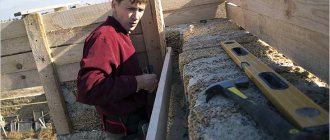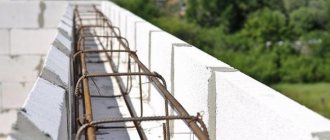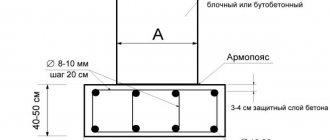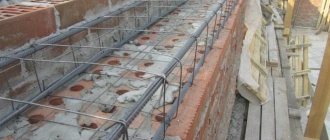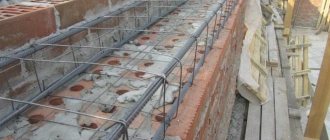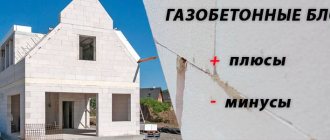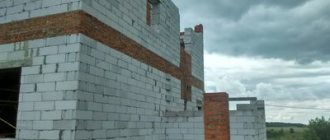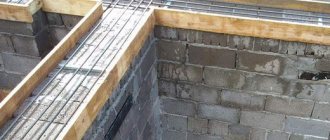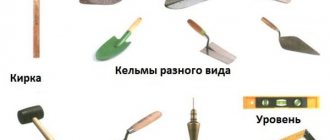The construction of a residential building from porous block wall materials is popular for a number of reasons. The main one: with minimal construction skills, such a building can be erected quickly and easily. But to strengthen walls made of gas silicate, foam concrete, expanded clay concrete and other similar lightweight materials, an additional construction operation is required - the installation of a reinforced belt. As a rule, monolithic concrete is used for its construction, but the use of ordinary solid ceramic bricks is quite acceptable.
An armored belt made of bricks on walls made of aerated concrete is a conventional masonry reinforced with reinforcement.
This complementary structure is performed at various stages of wall construction, depending on the purpose.
What is an armored belt?
A reinforced belt, also known as a monolithic belt or seismic belt, is a special design designed to solve two problems. First, distribute the load from what will be on top to what will be below. And, secondly, to connect the entire plane on which it is located into a single whole. Both a monolithic concrete armored belt and a reinforced brick one cope with load distribution. Both of them do an excellent job of distributing the load, say, from floor slabs to walls. If the task is also to connect the walls into a single whole, for example, from the bursting load of the roof rafters on the walls of the house, then a reinforced concrete belt is needed.
Requirements
The dimensions of the belt are selected in accordance with the design characteristics of the gas blocks on which they plan to install it.
They are obtained by calculation, which is carried out during the design, on the basis of existing construction regulatory documentation.
Basic requirements for installing armored belts on aerated concrete walls:
How to make an armored belt with your own hands
Now that we’ve figured out what an armored belt is, let’s find out how to make it with your own hands. With a brick armored belt, everything is simple. Typically, masonry is made of solid red brick of minimum grade M100 in several rows with reinforcement with masonry mesh. You can also reinforce the masonry with reinforcement with a diameter of 6-8 mm. With a concrete, monolithic armored belt, the situation is more complicated.
First you need to set up the formwork. This can be either wooden formwork or “tray” or permanent formwork, if we are talking about an armored belt on aerated concrete or foam concrete blocks. You can use factory U-blocks or make your own trays. To do this, it is not necessary to cut a U-block from a regular gas block. It is enough to make masonry from a thin gas block on the outside and inside. The space between these blocks can be insulated with extruded polystyrene.
After you have made the formwork, a reinforcement frame is placed inside the tray.
Sufficient reinforcement for an armored belt measuring 200 by 200 mm is a frame of 4 threads of reinforcement with a diameter of 12 mm (two on top and bottom), fastened with transverse clamps with a diameter of 6-8 mm every 30-50 cm.
The standard overlap of reinforcement should be 30-40 diameters. That is, if you are laying 12 mm reinforcement, then when building it up, you need to make an overlap of about 40 cm.
In corners, the reinforcement must be bent so that the corner is connected by solid reinforcement.
It is advisable to place the frame made of reinforcement on plastic clamps of the thickness of the protective layer of concrete. And put the clamps on the vertical clamps. If there are no factory fixings for the protective layer, you can use pieces of stone, brick, etc.
Pins under the Mauerlat or pieces of reinforcement are attached to the reinforcement frame for subsequent fixation of the floor slabs.
Now you can proceed directly to pouring the reinforced belt with concrete.
If you will be pouring purchased concrete, choose the M200-M250 brand. This grade of strength is absolutely enough for private construction.
If you plan to prepare concrete for pouring the armored belt yourself, then use the universal recipe for the proportions of concrete for the armored belt: 1 part 500 grade cement, 2 parts sand, 4 parts crushed stone.
You can also use one of our construction calculators to calculate the composition of concrete. Don't forget to add concrete plasticizer to the mix. This will make the filling more convenient for you, and the resulting armored belt more durable.
After pouring, cover the armored belt with film to prevent sudden drying. For the same purpose, wet the concrete for the first 2-3 days.
The armored belt will be ready for loading in a week. Full maturation of concrete will be completed 28 days after pouring.
When is it needed?
This armored belt is made in the form of a not very large strip of continuous masonry, which is reinforced with longitudinal steel rods or mesh. This is explained by the fact that, according to their production characteristics, aerated concrete blocks, even with good compressive strength, are completely unable to withstand bending, which causes premature cracking of the walls “in real life.”
Of course, in terms of strength, such a structure cannot be equal to a concrete monolithic belt , but for many low-rise construction projects, its characteristics are quite sufficient to create strong load-bearing aerated concrete walls.
The reinforced belt takes on the main loads, preventing the load-bearing walls from moving relative to each other at the moment of exposure to forces of different directions or sizes.
An additional function that the armor belt is capable of performing is to serve as a mounting location for important reinforced elements of an object on anchors when the wall itself is not able to bear them. Therefore, the developer must first make a kind of dividing brick belt in accordance with the technology specified in the house design.
Reference . There are several types of reinforcement: longitudinal, vertical and transverse. The first two methods are used in seismic construction areas, and the latter ensures the stability of the structure through the use of a specialized masonry mesh and is used everywhere when foam concrete blocks are used as wall material.
The device of a double armored belt installed under the foundation base and its upper section when using a column-type foundation has shown very good results in practice. Seasonal soil movement with this option of strengthening the object will not be able to “play” with the supports, since they become a common truss, rigidly fixed by 2 ligaments.
The most frequently asked questions on the topic of reinforced belts.
In what cases is an armored belt needed?
A monolithic reinforced concrete belt is required:
- on a block foundation
- on walls made of aerated concrete, foam blocks, etc. under hollow-core slabs and wooden floor beams (to prevent squeezing). Here the armored belt can be brick
- under the Mauerlat on the roof, the design of which assumes a spacer load on this same Mauerlat
Is it possible to fill the armored belt in winter, in cold weather?
Filling an armored belt in winter is a questionable task. However, if you really need to fill it in the cold season, take all measures to protect the concrete. Add special anti-frost additives to concrete. Use as little water as possible to mix concrete. After pouring, be sure to cover the armored belt to protect from the cold. For example, sawdust. In sub-zero temperatures, use a special heating cable. It is sold in any construction supermarket.
What is the minimum thickness, height, width, size of the armored belt?
The minimum size of the armored belt is 150 by 150 mm. But not less than the width of the support of the slabs or floor beams.
The armored belt freezes, what should I do?
If you or your workers forgot to insulate the armored belt before pouring, then you will have to insulate it now. The armored belt is insulated from the outside.
Condensation on the armored belt. The armored belt is sweating. What to do?
Insulate. Other options: increase the room temperature, reduce the room humidity.
Is it possible to fill the armored belt in parts?
Can. To do this, make a bevel at the junction. And the concrete doesn't have to be smooth.
Waterproofing and insulation
The thermal conductivity of brick is much higher than that of aerated concrete. Therefore, it is recommended to insulate the brick belt. This can be done in various ways, much depends on further options for finishing the internal and external walls of the building. One of the most common insulation options is that the armored belt is hidden behind a thin aerated concrete partition located on the interior side.
After the mortar has set, the top of the masonry is covered with a waterproofing layer of roofing felt or its analogues. This will prevent the formation of condensation on wooden structures supported by an armored belt.
Video on the topic of reinforced belt
A reinforced belt is a closed reinforced concrete monolithic structure that runs along the perimeter of the entire building.
An armored belt is needed to increase the building's resistance to deformation and various types of loads, such as exposure to wind, temperature changes, uneven shrinkage of the structure and the ground underneath it. If the building is being built from gas silicate, then the presence of an armored belt is simply necessary. This is explained by the fact that gas silicate blocks are not resistant to deformation and do not tolerate point loads well. If you decide to build a house with more than one floor, then there should be more than one armored belt. The presence of a reinforced foundation is the main condition for construction. Now let's figure out how to make a reinforced belt, and what is required for this.
An interfloor or unloading belt is constructed not only to strengthen the walls, but also to evenly distribute the load from the slabs over the entire structure.
There are 4 main types of armored belts:
- grillage;
- base armored belt;
- interfloor belt;
- unloading belt.
To mix concrete, you can use a commercial concrete mixer, or you can make one yourself.
Before we start making a reinforcing belt, let's prepare the tools and materials that will be needed:
- boards;
- sand;
- cement;
- crushed stone;
- fittings;
- wire to knit reinforcement;
- self-tapping screws;
- concrete mixer;
- welding machine;
- shovel;
- brick;
- crowbar or crowbar.
Is it worth making an armored belt out of brick?
So is it worth the risk and instead of making a full-fledged armored belt from concrete and reinforcement, make an armored belt from brick? In our opinion - no! Brick masonry is only slightly stronger than block masonry, even if it is reinforced. Two or three rows of bricks will not be able to evenly distribute the entire load along the walls. This will lead to the fact that some fragments and sections of the brickwork will experience increased pressure compared to the rest of the wall, and this is dangerous due to the appearance of cracks and even complete destruction of the wall. Therefore, it would be right not to take risks and make full reinforcement with an armored belt made of reinforced concrete.
A monolithic belt is a reinforced reinforced concrete beam, which is made mainly under the ceiling of masonry walls.
At first glance, the purpose of such a belt is unclear: you can, after all, support the ceiling directly on the masonry and not install any belts. As they say, “cheap and cheerful.” Let’s look at the reasons for constructing a monolithic belt.
1. If the masonry material of the walls does not bear the load from the floor. In a brick wall made of solid brick, for example, a monolithic belt is not needed, but in a wall made of cinder block, when supporting the ceiling of a large span, such a belt is necessary.
At the point where the slab is supported, a significant load is concentrated (from the ceiling, floors, people and furniture), and all of it does not fall evenly on the wall, but increases in the direction where the slabs are supported. Some masonry materials (cinder block, foam and aerated concrete, shell rock, etc.) do not work well when exposed to such a concentrated load, and may simply begin to collapse. This type of failure is called crushing. You can perform a special masonry calculation to determine whether a monolithic distribution belt is needed. But in some cases (when using cinder block, foam concrete), a monolithic belt must be made for design reasons based on experience in construction from these materials.
2. If the building is being built on weak soils (for example, subsidence). Such soils tend to deform significantly after some time, due to soaking or other unfavorable factors - to shrink under the weight of the building. In this case, part of the house may sag, resulting in cracks in the walls and foundation. One of the measures that protects against the adverse effects of subsidence is the installation of a continuous monolithic belt under the floors. It serves as a screed for the house and, with minor precipitation, can prevent the formation of cracks. If you are going to build a house, first of all inspect the houses in the neighboring areas (preferably those that were built a long time ago). If there are inclined cracks in the walls, running from the ground up, from the roof down, or from the corners of the windows up, then this is the first sign that a monolithic belt in your house will not be superfluous.
3. If a house is being built in a seismic area (in Ukraine this is Crimea), the installation of monolithic belts is mandatory.
4. In multi-storey buildings, the standards also require the installation of monolithic belts.
How to make a monolithic belt - see the topic “Prefabricated floor or monolith”
.
Attention!
For the convenience of answering your questions, a new section “FREE CONSULTATION” has been created.
Types of reinforced belts
Lower armored belt
Drawing of a reinforcing belt for the foundation.
The grillage is the lower, in most cases underground, belt. This is a foundation belt. First, let's dig a trench for the foundation. At the bottom of the trench you need to pour a layer of sand with crushed stone 50-100 mm thick, that is, make a sand cushion, and then build the formwork. For its construction, boards are most often used, which are attached to the wall from below using self-tapping screws. The opposite walls of the formwork are fastened with transverse ties made of boards. It is recommended to leave a void of 3 cm between the formwork and the wall, and after pouring concrete, it is filled with thermal insulation material. The height of the reinforced belt for the foundation should be 30-40 cm, and the width should be equal to the width of the wall.
Armored belt insulation scheme.
Next, a reinforcement frame for the reinforced belt is made. To do this, you will need reinforcement rods, from which a “ladder” is made by connecting them with jumpers. The distance between the lintels is about 50 cm and they are attached to the reinforcement using knitting wire, and at the joints and intersections of the walls - using welding, which is used only in these places, since it impairs the strength of the reinforcement. It is best to use reinforcement with a diameter of 12-14 mm, and for jumpers - 8 mm. It is better to make the frame already in the formwork, since when assembled it is very heavy and placing it correctly will be very problematic. Place pieces of bricks or blocks under the bottom of the frame so that it does not come into contact with the bottom, otherwise it will rot. The concrete should cover the reinforcement on all sides by 5 cm. If you plan to use light concrete floors, then it will be enough to take 2 rods of reinforcement for the frame, but if the floor is heavy, then you need to take 4 reinforcing rods.
Now we begin to fill the reinforced belt for the foundation with a concrete mixture. It is made by mixing 1 part cement, 3 parts sand and 5 parts crushed stone, adding water. When the mixture is poured into the formwork, do not forget to get rid of the voids inside it. You need to use reinforcement or a special tool to compact the concrete using the bayonet method. It is important to remember that filling should be done immediately, in one step. If the weather is good outside, then after 5 days the formwork can be removed. The formwork must be removed using a crowbar or crowbar. The armored belt for the foundation is ready.
Basement, interfloor and unloading belts
Foundation reinforcement diagram.
The base armored belt is constructed next after the foundation belt and is placed along the top of the base of the structure. If you have made the grillage correctly, then this belt does not need to be strengthened too much, that is, you can do without a frame. The height of such a belt should be 210-400 mm, but if you make it 400 mm, the structure will be more reliable and stronger. If in the future you will insulate external walls, then the width of the armored belt is equal to the width of the wall, and if not, then the width of the belt must be made taking into account the insulation layer. The process of pouring the concrete mixture is the same as for the grillage.
The interfloor belt is made to evenly distribute the load from the concrete slabs over the entire frame of the house and to strengthen the walls. This belt is laid only around the perimeter of the external walls. Since it takes the entire load upon itself, lintels over window openings can be made with minimal use of reinforcement and minimal thickness. It is better to make the formwork for the third belt from brick: face brick is used on the outside, backfill is used on the inside.
The unloading or roof belt takes the load from the roof and rafter system, and also allows you to secure the power plate. This belt must be made in the same way as the previous ones.
The reinforced belt is a necessary element of the supporting structure and the costs of its production are fully justified. You can save on wallpaper, paint and other materials, but not on such an important element as an armored belt.
- 1 Types
- 2 Tools and materials
- 3 Manufacturing of reinforcing mesh/frame
- 4 Formwork
- 5 Grillage
- 6 Base armored belt
- 7 Interfloor
- 8 Under the Mauerlat
- 8.1 Mounting the Mauerlat
- 9 Reinforced belt for aerated concrete
- 10 Videos
An armored belt is a reinforced concrete structure that is designed to strengthen the walls of a house. This is necessary to protect the walls from loads arising under the influence of external/internal factors. External factors include wind exposure, terrain slope/hilliness, floating soil and seismic activity of the earth. The list of internal factors includes all household construction devices used in the interior decoration of the house. If you make an armored belt incorrectly, then due to these phenomena the walls will simply crack, and what’s even worse, they will corrode. In view of this, it is very important to be aware of how to make an armored belt. The types, purpose and method of installation of the armored belt will be discussed in this article.
Sequence of preparatory operations
For an armored belt, you can complete all stages of work with your own hands if you carefully study the technological process and purchase everything you need in a timely manner. Installation work stages include:
- Preparing for installation.
How to make formwork strong? What materials are needed? To arrange the frame, use ordinary wooden boards with a thickness of at least 40 millimeters. The width of the boards should be about 200 millimeters. Using special guide elements, it is necessary to fasten the formwork with nails to ensure rigidity. The length of the nails up to 120 millimeters allows for reliable fixation of the formwork for the armored belt. Carefully bend the protruding parts of the nails. For the reliability of the structure, guides to the capital elements of the building should be fixed.Reinforcing belt (seismic belt) - increases the reliability of the house and prevents the appearance of cracks
- Ensuring immobility.
The dimensions of the guide elements, made of beams or boards, must correspond to the thickness of the wall. The shape is fixed to the boards using nails. The formwork for the armored belt must be rigid and not diverge when pouring concrete mortar. - Sealing joints.
We plug the end slots with a thick solution, which should not flow outward and remain inside the perimeter. You can also add polyurethane foam or film to seal the cracks.
Using these recommendations, you will receive high-quality formwork for the belt, which will have the necessary characteristics.
Manufacturing of reinforcing mesh/frame
In order for the reinforced belt to be of high quality, and therefore the house to be reliable, you need to know how to properly make the reinforced mesh/frame. The connection of the reinforcement bars to each other is carried out using a knitting wire, and not a welding seam. This is due to the fact that during welding, the area near the seam being made overheats, which leads to a weakening of the strength of the reinforcement. But you can’t do without welding seams when making mesh. The middle and ends of the frame are welded, while the remaining connecting nodes are tied together.
The frame is laid in an armored belt.
The rods are fastened to fix the reinforcement in the required position when pouring concrete. For these purposes, thin wire is used; the strength of the mesh/frame does not depend on it.
For the manufacture of armored belts, only ribbed rods are used. Concrete clings to the ribs, which helps to increase the load-bearing capacity of the structure. Such a belt can work in tension.
To make a frame, take 2 wires 12 mm thick and 6 m long, while for transverse reinforcement you will need rods 10 mm thick. The transverse reinforcement should be welded in the center and edges. The rest of the rods are simply knitted. After making two meshes, hang them so that a gap is formed. Weld them from the edges and in the center. This way you will have a frame. There is no need to weld the frames to make the belt. They are laid with an overlap of 0.2–0.3 m.
Errors during construction
Technology violations include:
• Using heterogeneous concrete mixtures or pouring the belt with long technological breaks.
• Savings on reinforcement, namely the use of rods with a cross-section of less than 8 mm2, no overlap at joints and
• The absence of an insulating or insulating layer, shifted to the outer edge, which in turn leads to the formation of “cold bridges” and the accumulation of condensate in blocks adjacent to the reinforced belt. With external insulation of the facade, this problem manifests itself less, but it cannot be ignored. In practice, this means that when determining the width of the reinforced belt and the need for its insulation, you need to know in advance how the facade will be finished.
Formwork
Installation and fastening of formwork is carried out using several methods. To install wooden panels, you need to pass anchors through them and install plugs on them using electric welding. The purpose of these actions is to fix the formwork in such a way that it is not squeezed out under the weight of the concrete.
To secure the formwork when pouring an interfloor armored belt, a simpler method is often used. A screw with a diameter of 6 mm and a length of 10 cm should be fixed to the bottom of the shield. The distance between them is 0.7 m. So, attach the wooden shield to the wall, drill a hole through it, insert a mushroom into it and drive the screw.
The hole in the shield should be slightly larger than 6 mm in diameter. This is necessary in order to easily install the fungus.
Wooden formwork
The upper part of the formwork is also secured with quick installation. But in this case, you should screw in a self-tapping screw, not a screw. So, make a hole in the face brick. Then drive the reinforcement into it. If the brick is solid, then the situation is simpler - just drive a nail/reinforcement into the vertical seam. Tighten the self-tapping screw and reinforcement with binding wire. The distance between fastening elements is 1–1.2 m. Such fastening is capable of withstanding the upcoming loads.
After the armored belt has hardened, the formwork can be removed using a crowbar/nail puller. In the warm season, concrete sets within a day. In this case, the dismantling of the formwork can be carried out the next day. During the cold season, this procedure is carried out a few days later.
Installation of fittings
Sequence of actions for installing the reinforcement cage:
- Cutting metal rods.
- Laying rods along the formwork on pads.
- Wiring the elements of the lower tier.
- Installation of cross bars.
- Attachment to vertical rods of upper level elements.
After assembling the reinforcement grid, install threaded rods or steel wire to secure the floor elements.
Grillage
Initially, you should determine the depth of the foundation. This parameter depends on the type of soil, the depth of its freezing, as well as the depth of groundwater. Then you should dig a trench around the perimeter of the future house. This can be done manually, which is long and tedious, or with the help of an excavator, which is quick and efficient, but entails additional costs.
After special equipment is used, the bottom and walls of the trench should be leveled to solid ground. The surface should be as hard and smooth as possible.
Now you need to form a sand cushion, the height of which should be 50–100 mm. If it is necessary to backfill sand more than 100 mm, it must be mixed with crushed stone. This activity may be necessary to level the bottom of the trench. Another way to level the bottom is to pour concrete.
Making a frame for a grillage
After filling the sand cushion, it must be compacted. To complete the task faster, pour water on the sand.
Then the reinforcement should be laid. During the construction process, under normal conditions, you need to use reinforcement of 4–5 cores, the diameter of each rod should be 10–12 mm. It is important that when pouring the grillage for the foundation, the reinforcement does not touch the base. It must be recessed in concrete. Thus, the metal will be protected from corrosion. To achieve this, the reinforcing mesh should be raised above the sand cushion, placing brick halves under it.
Strip foundation grillage
If you are building a house on heaving soil or where the groundwater level is high, then the grillage should be made more durable. To do this, instead of reinforcing mesh, you should use a reinforcement cage. He imagines 2 meshes consisting of 4 wires with a diameter of 12 mm. They should be laid below and above the armored belt. Granular slag is used as a base instead of a sand cushion. Its advantage over sand is that over time, granulated slag turns into concrete.
To make the mesh, a knitting wire is used rather than a welding seam.
For the grillage, M200 concrete should be used. To ensure that the filling height corresponds to the specified value, install a beacon in the trench - a metal peg equal in length to the height of the grillage. It will serve as your guide.
Pouring concrete mortar
The required strength can be ensured by following the following recommendations:
- The formwork for the armored belt is concreted using technology in one step;
- carry out work continuously;
- It is advisable to pump the solution directly into a wooden form using a concrete pump;
- pour concrete until it covers the reinforcement to a depth of 5 cm;
- it is preferable to use concrete with a grade of at least M 200;
- Air cavities that negatively affect strength are unacceptable. To eliminate this, use special vibrators;
- the use of plasticizers improves the fluidity of the mixture, reduces the concentration of water, which shortens the hardening time of concrete;
- the concrete mass must stand for 3 weeks;
- during hot periods, moisten the surfaces generously with water to prevent cracks and strengthen the hardened mortar.
Base armored belt
Before erecting walls, a basement reinforced belt should be poured onto the foundation. It must be poured along the perimeter of the building along the external walls, but this cannot be done along the internal load-bearing walls. The base armored belt serves as additional reinforcement of the structure. If you have filled the grillage with high quality, then the plinth belt can be made less durable. The height of the armored belt is 20–40 cm, concrete M200 and higher is used. The thickness of two-core reinforcing bars is 10–12 mm. The reinforcement is laid in one layer.
If you need to strengthen the base belt, then use reinforcement of greater thickness or install more conductors. Another option is to lay the reinforced mesh in 2 layers.
Formwork for the basement armored belt
The thickness of the basement and external walls is the same. It ranges from 510 to 610 mm. When pouring the base armored belt, you can do without formwork, replacing it with brickwork. To do this, you need to make half-brick masonry on both sides of the wall. You can fill the resulting void with concrete after placing reinforcement in it.
In the absence of a grillage, it is useless to make a base armored belt. Some craftsmen, having decided to save on the grillage, strengthen the base belt, using reinforcement of a larger diameter, which supposedly improves the load-bearing capacity of the house. In fact, such a decision is unreasonable.
The grillage is the foundation of the house, and the plinth belt is an addition or strengthening of the load-bearing capabilities of the reinforced belt for the foundation. The joint work of the grillage and the plinth belt guarantees a reliable foundation even on heaving soils and with a high level of groundwater.
Interfloor
An armored belt must also be made between the wall and the floor slabs. It is poured along external walls with a height of 0.2 to 0.4 m. Interfloor armored belt allows you to save on door/window lintels. They can be made small and with a minimum of reinforcement. Thus, the load on the structure will be distributed evenly.
If an armored belt is installed on walls made of poorly load-bearing material, the load from the floor slabs will be distributed evenly along the entire length of the walls, which will have a beneficial effect on their strength characteristics.
Formwork for interfloor reinforced belt
Reinforcement of the interfloor belt is performed with a mesh of ribbed reinforcing bars 10–12 mm thick in 2 cores. If the thickness of the walls varies between 510–610 mm, then double-sided brickwork can be used as formwork, as for the base belt. But at the same time, backing bricks should be used for internal masonry, and facing bricks for external masonry. In this case, the armored belt will have a width of 260 mm. If the walls are thinner, the backing brick should be laid on edge or wooden formwork should be used instead, and the facing brick should be laid on the outside in the same way as in the previous case.
Step-by-step creation technology
Such an armored belt is raised from 4 to 7 rows high and with the width of an aerated concrete wall using an iron mesh matrix of 30 or 40 mm or reinforcement D = 5 mm.
The masonry technology corresponds to conventional brick walls with the seams offset by one third of the length and the 3rd row bonded.
If the reinforcing protective belt for gas-block walls becomes a supporting structure for the Mauerlat, vertical pin reinforcement with thread D 12/16 mm is walled into it, every 1.5 m and with a depth equal to the size of the beam and 2 times longer than the freed end for fastening the Mauerlat.
The reinforcement contour under the roof performs a unloading function and becomes a strong support for the mauerlat beam. In the case where the project provides for the installation of lightweight slabs, it will be necessary to install a brick armored belt on both the internal and load-bearing wall structures, since they will be the ones that will experience the loads.
Important ! The belt in this version is designed to create a special buffer that will evenly distribute the pressure created by the slab over the total wall area, while preventing sagging of the supporting structure.
Basic stages of laying a brick armored belt on aerated concrete:
Under the Mauerlat
The armored belt can be poured under the Mauerlat only after the glue/mortar for masonry walls has hardened. The technology used to lay the reinforced belt on aerated concrete differs in the formwork design, but we will talk about this a little later. The production of wooden formwork is carried out according to a scheme already familiar to you. Concrete is prepared according to the following formula: 2.8 parts sand to 1 part cement and 4.8 parts crushed stone. Thus, you will get M400 concrete.
After filling, eliminate any remaining air bubbles in the mixture. To accomplish these tasks, use a construction vibrator or poke a rod into the liquid mass.
Mounting the Mauerlat
When constructing a monolithic armored belt, the rules for fastening the Mauerlat must be observed. During the installation of the reinforcement frame, vertical sections should be removed from it to the height specified in the project. The reinforcement bars should rise above the reinforced belt by the thickness of the Mauerlat + 4 cm. Through holes must be made in the beam equal to the diameter of the reinforcement, and threads should be cut at its ends. So, you will get a reliable fastening, which will give you the opportunity to carry out high-quality installation of a roof of any configuration.
Embedded studs
Sometimes, in order to secure the Mauerlat, studs with a diameter of 12 mm or more are pre-installed on the armored belt, protruding 3-4 cm above the Mauerlat. The installation step of such studs is 100 cm: they are attached to clamps with knitting wire.
As for the question of the feasibility of making a Mauerlat in the presence of a reinforcing belt, then indeed, theoretically, the rafters can be fixed to the belt. However, in practice this will require a significant number of additional measures. So it’s much easier to go the traditional route of using a reinforced belt under the Mauerlat.
Source
Reinforced belt for aerated concrete
Aerated concrete is an alternative to brick, which has high thermal insulation qualities along with low cost. Aerated concrete blocks are inferior to brick in strength. If when installing an armored belt on brick walls it is not necessary to pour concrete, since the reinforcement is laid during the laying process, then with aerated concrete things are different. How to make an armored belt on wooden formwork has already been discussed above, so in this subsection we will look at how to make a reinforced belt from U-shaped aerated concrete blocks D500. Although it is worth noting immediately that this technology is more expensive.
In this case, everything is extremely simple. Place the blocks on the wall as usual. Then reinforce their central part, and then fill it with concrete. Thus, the walls of your home will be more durable and reliable.
If you still have questions on the topic, then ask them to a specialist working on the site. If necessary, you can consult with our expert about filling the armored belt. Do you have personal experience? Share it with us and our readers, write comments on the article.
Functional purpose
The reinforced frame performs a number of important tasks:
- maintaining the contour and preventing wall deformation during soil shrinkage and earthquakes;
- leveling the structure being erected in the horizontal plane and eliminating errors made during laying;
- ensuring the rigidity of the building under construction;
- distribution of local or point forces along the supporting plane of load-bearing surfaces;
- fixation of a closed line, which is the basis for fastening the roof.
Regardless of your plans to place an attic above the first floor of the house, the next floor or the roof, remember that you need to take care of strengthening the structure!
Boards for future formwork should be located outside the wall, and not inside, that is, rest against the wall, in the masonry overlay by 2-4 centimeters
